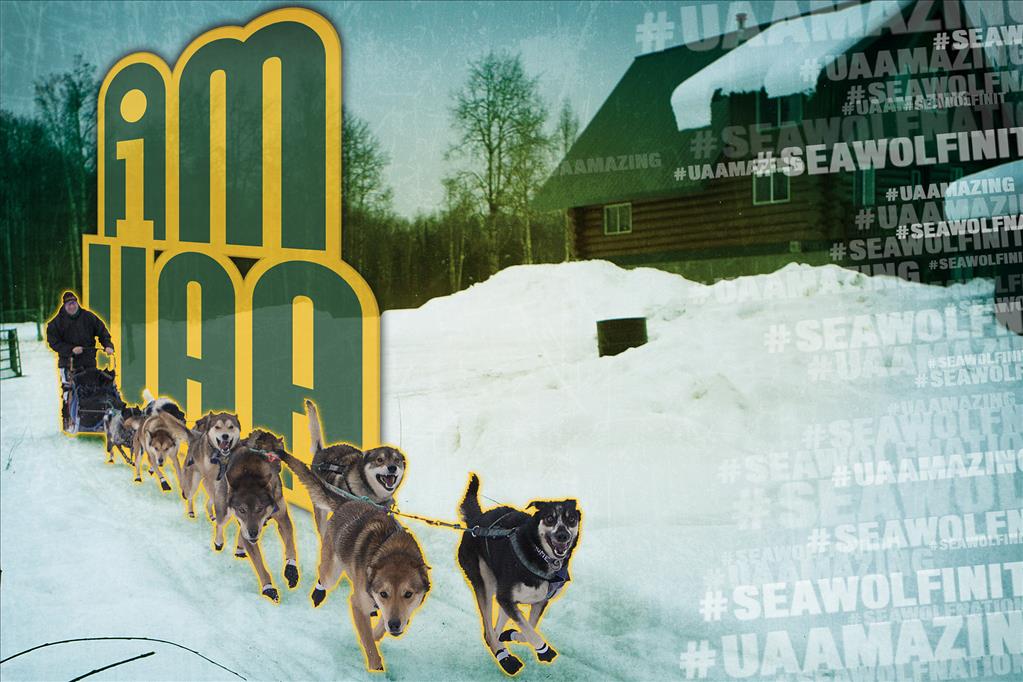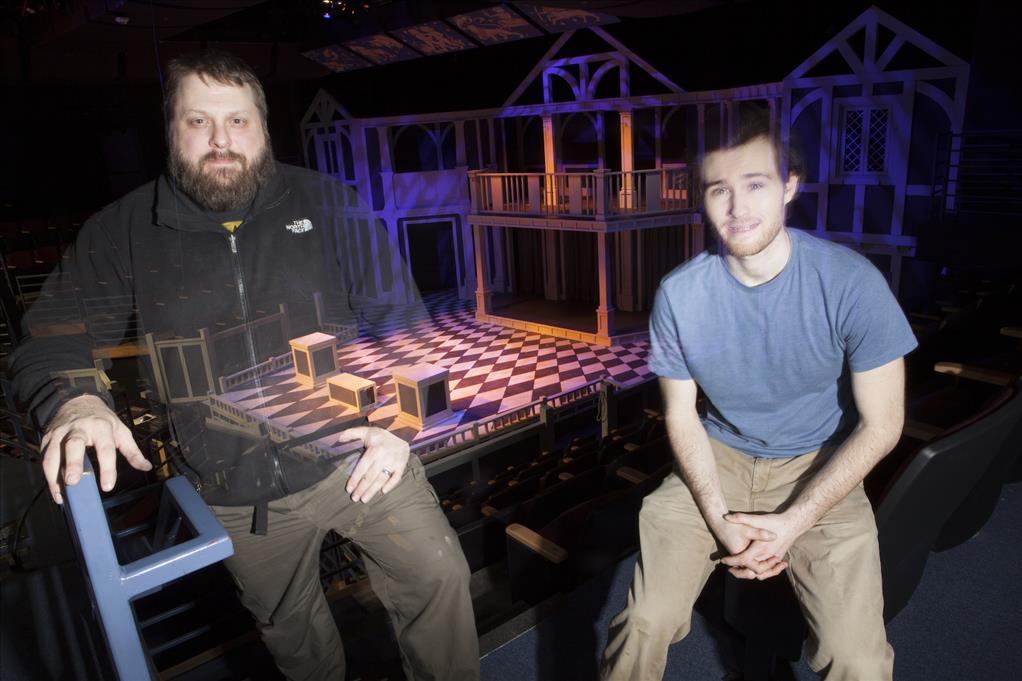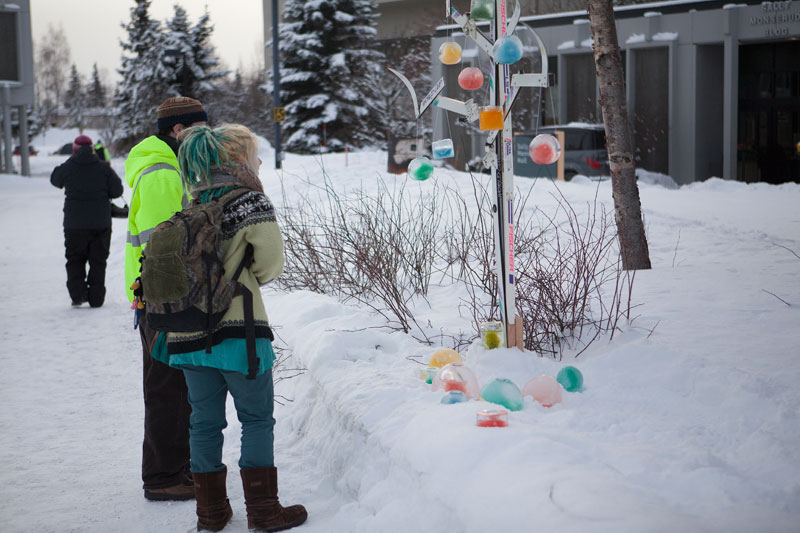Training for a canoe marathon, running a surprise Iditarod
by Jamie Gonzales |
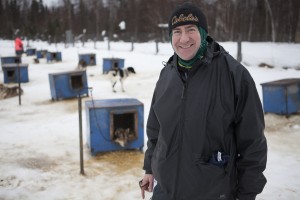
I AM UAA: Bryan Bearss, M.Ed. Educational Leadership '13, in between runs at Blue on Black Kennels outside Talkeetna. (Photo by Philip Hall/University of Alaska Anchorage)
If you'd asked Bryan Bearss before Thanksgiving what he had planned for spring break, he certainly wouldn't have told you he was taking a few days off to run the Iditarod. Most mushers spend close to a year planning and training for a grand undertaking like the Iditarod. But Bryan's surprise Iditarod rapidly began taking shape after a couple bedside hospital visits with his friend, musher Karin Hendrickson. She was laid up after being hit by a car Nov. 25 on a training run with her dog team.
"She's like, 'What do you think about [running the Iditarod]? It's a win-win-you get the dogs out there for me and they're ready for next year and I know you've been itching to get back on the sled,'" said Bryan, recalling their conversation at Alaska Regional Hospital in November. By Dec. 1, he was back on the runners, his 10-year plan to return to mushing on super-fast-forward. Karin remains on board as a coach, helping to plan training runs and manage trail logistics during the week while Bryan continues to work full-time.
Monday through Friday this College of Education grad (M.Ed. Educational Leadership '13) is an early literacy coach with the Anchorage School District. Every Friday, almost as soon as that school bell rings, he embarks on the two-hour drive to Talkeetna's Blue on Black Kennels to run dogs, getting them, and himself, in shape for the "Last Great Race on Earth." No lazy weekends for this teacher until after the 2015 Iditarod, Bryan's second. He completed his first race in 2006, running a team of young dogs from Dr. Robert Bundtzen's kennel.
Having three months to prep for the 1,000-mile race isn't ideal. Luckily, most of the athletes-Karin's 28 dogs-have been training for much longer. Bryan had also been in training for months, prepping for a 120-mile canoe marathon in his native Michigan in July.
"I at least had a base of physical fitness to work with," he said. "Reality? As a musher, you don't have to be an athlete, but it makes the race a lot easier for you if you're healthy. You'll stay warmer if you're healthier, more alert. If you're more alert, you can take better care of the dogs. The better care you take of the dogs, the better they're going to perform on the trail."
Recovering when lightning (or a car) strikes twice
While driving home from a weekend of training, right around Christmas, Bryan got into a car accident that injured his shoulder. Double bad luck for Team Blue on Black. But he's been working hard with physical therapists and his doctors to make sure he's in good shape to race. His injury hasn't slowed down their training regimen-two to four 40-60-mile runs with the dogs every weekend.
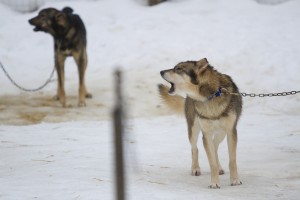
The official dog yard greeting for a returning musher. Must mean, 'My turn, coach!' at Blue on Black Kennels, Talkeetna, AK. (Photo by Philip Hall/University of Alaska Anchorage)
On a recent Saturday, he was up with the chickens, prepping dogs for a 4-hour run through rain and ice. We caught him on the turnaround (see the full slideshow below), pulling in to the dog yard with a still-zippy, though very wet, team. Even in the coldest temperatures, there's always a warm reception for a musher in the dog yard. With 28 dogs, Bryan and Karin's other handlers run them in shifts. The dogs who were left behind on the morning run had a lot to say when Bryan set the snow hook and started unclipping dogs from the sled's lead line. They needn't have worried, though. As fast as he could get the first shift of dogs stripped of booties and harnesses and settled into their houses, he was hooking up a fresh team, ready to hit the trail for his second Saturday run. (Watch/listen to a 10-second video of the team taking off.) He did manage a five-minute break to change into some luxuriously dry snow pants, even though, like most mushers, he has a high tolerance for discomfort.
There's a clear line between discomfort and danger on the trail, however, which is why Bryan was relieved to hear the race was being rerouted with a Fairbanks restart. The more northerly route is designed to keep the mushers and dogs on a safer, snowier track. Good news for a guy who might have to hang on with just one arm at times. If you followed Iditarod coverage last year, you probably saw Jeff King's video of his bone-shaking run through Dalzell Gorge, a section every musher was dreading this year. The new route will bypass that portion of the trail.
Classroom coaching and trail coaching
"I always said when I go back out again I want to take a puppy team, which is what I had on my first run," Bryan said. "Puppy teams are more developmental-you get to watch them grow, which was super rewarding my first time. As a teacher, that's what I'm all about-teaching and watching that growth happen."
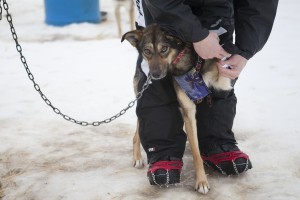
Time for booties. Tilt-a-Whirl gets suited up for a run at Blue on Black Kennels. (Photo by Philip Hall/University of Alaska Anchorage)
Before he became an early literacy coach, working with ASD teachers to give them the tools they need to help their K-3 students excel, Bryan spent years in ASD classrooms as an elementary school teacher, primarily teaching kindergarten. Teaching kids and training Iditarod athletes isn't as different as you'd think.
He entered his first Iditarod lured by the opportunity to see the effects of his day-to-day coaching and training. "My true love was the training," he said. "I'm really a teacher at heart." His 2006 Iditarod team was made up of mostly yearling dogs he'd been with since the day they were born. He took them on their very first runs and helped shape them into young athletes. How could he pass up the chance to see the dogs run their "high school graduation" race?
When he's on the trail these days, he brings his day job with him. "It's quiet time, thinking time about work, thinking time about life. I'm watching the dogs and it's just Zen," he said. "I coach teachers and being on the sled gives me a lot of time to think, 'OK, how was the coaching this week? How can I improve on that coaching for next week?'"
And once he's finally on the trail out of Fairbanks, Bryan will be enjoying his twice-in-a-lifetime chance to live in the moment. "Life is pared down to the necessities out there. All I have to focus on is what's in front of me. That's about all we can control," he said. "Mushing really allows you to do that."
Follow Bryan's race(s)
Longtime Iditarod fan or Iditarod newbie, you can follow race coverage through most Alaska news outlets as well as on Iditarod.com. The Anchorage ceremonial start is Saturday, March 7, the first day of Bryan's spring break, a fortuitous coincidence. Teams restart in Fairbanks on Monday, March 9.
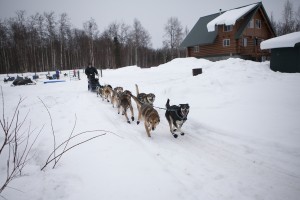
Bryan's second run of the day from Blue on Black Kennels, with Nome in lead beside Muddy Waters. (Photo by Philip Hall/University of Alaska Anchorage)
Running lead for the Blue on Black team is a dog named Nome. "We're hoping Nome leads us safely to Nome this year," Bryan said.
When Bryan returns from two weeks on the trail in late March, he'll be reevaluating his next athletic endeavors. Shoulder-willing, he'll compete in the canoe marathon in July and a more traditional running marathon in Alaska in September. He calls it his own cobbled-together 2015 triathlon-mushing, paddling and running.
But who knows? If anyone needs to drop out of, say, the Tour de France, we know a really good sport you could call.
Keep up with Bryan's adventure on his "Karin's Run-North to Nome 2015" Facebook page.
Written by Jamie Gonzales, UAA Office of University Advancement
 "Training for a canoe marathon, running a surprise Iditarod" is licensed under a Creative Commons Attribution-NonCommercial 4.0 International License.
"Training for a canoe marathon, running a surprise Iditarod" is licensed under a Creative Commons Attribution-NonCommercial 4.0 International License.











